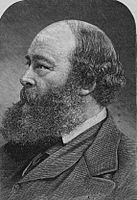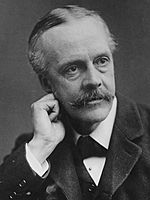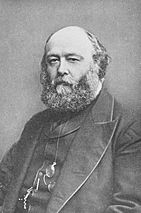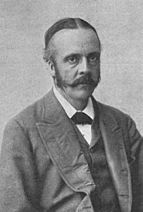Unionist government, 1895–1905 facts for kids
From 1895 to 1905, the United Kingdom was led by a government made up of two political groups: the Conservative Party and the Liberal Unionist Party. This type of government, where different parties work together, is called a coalition.
The leader of the Conservatives, Lord Salisbury, became the Prime Minister in 1895. His nephew, Arthur Balfour, was an important leader in the House of Commons. Other key roles went to members of the Liberal Unionist Party, like the Duke of Devonshire and Joseph Chamberlain. This government was in charge during the Second Boer War (1899–1902). Winning this war helped them get a huge victory in the 1900 election.
This government had three main periods. Lord Salisbury led the first two (from 1895 to 1902), and Arthur Balfour led the third (from 1902 until 1905).
Contents
What is a Prime Minister?
Lord Salisbury was the last person to be the head of the government without also holding the title of First Lord of the Treasury. For over a hundred years since then, these two jobs have always been held by the same person. The Prime Minister is the main leader of the country's government.
Changes to Trade Rules
Arthur Balfour became Prime Minister in 1902 after Lord Salisbury. The government started to have problems when Joseph Chamberlain suggested a new plan for tariff reform. This plan meant putting taxes on goods coming into the country. Some members of the government who believed in free trade (no taxes on imports) disagreed with this idea and resigned.
Chinese Workers in South Africa

After the Boer War ended, the British government wanted to rebuild South Africa's economy. The war had caused a lot of damage. A big part of this plan was to get the gold mines in Witwatersrand working again quickly. These mines were the richest in history and a major reason for the war.
The government decided that white workers were too expensive, and black workers didn't want to return to the mines. So, they brought in over 60,000 workers from China under special contracts.
Many people in Britain and other Western countries did not like this idea. There was a lot of negative feeling towards Chinese immigration at the time. This was also when many working-class British people were struggling with poverty and unemployment.
On March 26, 1904, about 80,000 people gathered in Hyde Park to protest against bringing Chinese workers to South Africa. The Trade Union Congress, a group representing workers, also spoke out. They said:
That this meeting consisting of all classes of citizens of London, emphatically protests against the action of the Government in granting permission to import into South Africa indentured Chinese labour under conditions of slavery, and calls upon them to protect this new colony from the greed of capitalists and the Empire from degradation.
This quote shows that many people felt the Chinese workers were being treated unfairly, almost like slaves. They wanted the government to protect the colony from greedy business owners and protect the British Empire's reputation.
The Government Steps Down
Arthur Balfour's government was losing support, and it looked like they would lose the next election. So, in December 1905, Balfour resigned as Prime Minister. This led to a new government being formed by the Liberal Party, led by Sir Henry Campbell-Bannerman.
In the general election that followed in 1906, almost all of Balfour's government ministers lost their seats in Parliament, including Balfour himself.
Government Teams
Salisbury's Governments
Quick facts for kids Salisbury ministries |
|
|---|---|
Unionist coalition of the United Kingdom |
|
|
|

Lord Salisbury (1897)
|
|
| Date formed |
|
| Date dissolved |
|
| People and organisations | |
| Monarch |
|
| Prime Minister | Lord Salisbury |
| Prime Minister's history | 1895–1902 |
| Member parties |
|
| Status in legislature |
|
| Opposition party | Liberal Party |
| Opposition leaders |
|
| History | |
| Election(s) | |
| Legislature term(s) |
|
| Predecessor | Rosebery ministry |
| Successor | Balfour ministry |
First Salisbury Government (1895-1900)
| Portfolio | Minister | Took office | Left office | Party | |
|---|---|---|---|---|---|
| The 3rd Marquess of Salisbury* | 25 June 1895 | 11 July 1902 | Conservative | ||
|
Arthur Balfour | 25 June 1895 | 4 December 1905 | Conservative | |
| Lord Chancellor | The Earl of Halsbury | 29 June 1895 | 4 December 1905 | Conservative | |
| Lord President of the Council | The Duke of Devonshire | 29 June 1895 | 19 October 1903 | Liberal Unionist | |
| Lord Privy Seal | The Viscount Cross | 29 June 1895 | 12 November 1900 | Conservative | |
| Home Secretary | Sir Matthew White Ridley | 29 June 1895 | 12 November 1900 | Conservative | |
| Colonial Secretary | Joseph Chamberlain | 29 June 1895 | 16 September 1903 | Liberal Unionist | |
| Secretary of State for War | The Marquess of Lansdowne | 4 July 1895 | 12 November 1900 | Liberal Unionist | |
| Secretary of State for India | Lord George Hamilton | 4 July 1895 | 9 October 1903 | Conservative | |
| First Lord of the Admiralty | George Goschen | 1895 | 1900 | Conservative | |
| Chancellor of the Exchequer | Sir Michael Hicks Beach | 29 June 1895 | 11 August 1902 | Conservative | |
| President of the Board of Trade | Charles Ritchie | 29 June 1895 | 7 November 1900 | Conservative | |
| President of the Local Government Board | Henry Chaplin | 29 June 1895 | 12 November 1900 | Conservative | |
| Chancellor of the Duchy of Lancaster | The Viscount Cross | 29 June 1895 | 4 July 1895 | Conservative | |
| The Lord James of Hereford | 4 July 1895 | 11 August 1902 | Liberal Unionist | ||
| First Commissioner of Works | Aretas Akers-Douglas | 4 July 1895 | 11 August 1902 | Conservative | |
| Lord Lieutenant of Ireland | The Earl Cadogan | 29 June 1895 | 11 August 1902 | Conservative | |
| Lord Chancellor of Ireland | The Lord Ashbourne | 29 June 1895 | 1905 | Conservative | |
| Secretary for Scotland | The Lord Balfour of Burleigh | 29 June 1895 | 9 October 1903 | Conservative | |
| President of the Board of Agriculture | Walter Long | 4 July 1895 | 16 November 1900 | Conservative | |
Second Salisbury Government (1900-1902)
In November 1900, some changes were made to the government team.
| Portfolio | Minister | Took office | Left office | Party | |
|---|---|---|---|---|---|
| The 3rd Marquess of Salisbury* | 25 June 1895 | 11 July 1902 | Conservative | ||
|
Arthur Balfour | 25 June 1895 | 4 December 1905 | Conservative | |
| Lord Chancellor | The Earl of Halsbury | 29 June 1895 | 4 December 1905 | Conservative | |
| Lord President of the Council | The Duke of Devonshire | 29 June 1895 | 19 October 1903 | Liberal Unionist | |
| Home Secretary | Charles Ritchie | 12 November 1900 | 12 July 1902 | Conservative | |
| Foreign Secretary | The Marquess of Lansdowne | 12 November 1900 | 4 December 1905 | Liberal Unionist | |
| Colonial Secretary | Joseph Chamberlain | 29 June 1895 | 16 September 1903 | Liberal Unionist | |
| Secretary of State for War | St John Brodrick | 12 November 1900 | 6 October 1903 | Conservative | |
| Secretary of State for India | Lord George Hamilton | 4 July 1895 | 9 October 1903 | Conservative | |
| First Lord of the Admiralty | The Earl of Selborne | 1900 | 1905 | Liberal Unionist | |
| Chancellor of the Exchequer | Sir Michael Hicks Beach | 29 June 1895 | 11 August 1902 | Conservative | |
| President of the Board of Trade | Gerald Balfour | 12 November 1900 | 12 March 1905 | Conservative | |
| President of the Local Government Board | Walter Long | 1900 | 1905 | Conservative | |
| Chancellor of the Duchy of Lancaster | The Lord James of Hereford | 4 July 1895 | 11 August 1902 | Liberal Unionist | |
| First Commissioner of Works | Aretas Akers-Douglas | 4 July 1895 | 11 August 1902 | Conservative | |
| Lord Lieutenant of Ireland | The Earl Cadogan | 29 June 1895 | 11 August 1902 | Conservative | |
| Lord Chancellor of Ireland | The Lord Ashbourne | 29 June 1895 | 1905 | Conservative | |
| Secretary for Scotland | The Lord Balfour of Burleigh | 29 June 1895 | 9 October 1903 | Conservative | |
| President of the Board of Agriculture | Robert William Hanbury | 16 November 1900 | 28 April 1903 | Conservative | |
Balfour's Government
| Balfour ministry | |
|---|---|
| 1902–1905 | |

Arthur Balfour
|
|
| Date formed | 12 July 1902 |
| Date dissolved | 4 December 1905 |
| People and organisations | |
| Monarch | Edward VII |
| Prime Minister | Arthur Balfour |
| Member parties |
|
| Status in legislature | Majority (coalition) |
| Opposition party | Liberal Party |
| Opposition leaders |
|
| History | |
| Legislature term(s) | 27th UK Parliament |
| Predecessor | Fourth Salisbury ministry |
| Successor | Campbell-Bannerman ministry |
| Portfolio | Minister | Took office | Left office | Party | |
|---|---|---|---|---|---|
|
Arthur Balfour* | 12 July 1902 | 4 December 1905 | Conservative | |
| Lord Chancellor | The Earl of Halsbury | 29 June 1895 | 4 December 1905 | Conservative | |
| The Duke of Devonshire | 29 June 1895 | 19 October 1903 | Liberal Unionist | ||
| Lord President of the Council | The Marquess of Londonderry | 19 October 1903 | 11 December 1905 | Conservative | |
| Leader of the House of Lords | The Marquess of Lansdowne | 13 October 1903 | 4 December 1905 | Liberal Unionist | |
| Home Secretary | Aretas Akers-Douglas | 12 July 1902 | 5 December 1905 | Conservative | |
| Foreign Secretary | The Marquess of Lansdowne | 12 November 1900 | 4 December 1905 | Liberal Unionist | |
| Colonial Secretary | Joseph Chamberlain | 29 June 1895 | 16 September 1903 | Liberal Unionist | |
| Alfred Lyttelton | 11 October 1903 | 4 December 1905 | Liberal Unionist | ||
| Secretary of State for War | St John Brodrick | 12 November 1900 | 6 October 1903 | Conservative | |
| H. O. Arnold-Forster | 6 October 1903 | 4 December 1905 | Liberal Unionist | ||
| Secretary of State for India | Lord George Hamilton | 4 July 1895 | 9 October 1903 | Conservative | |
| St John Brodrick | 9 October 1903 | 4 December 1905 | Conservative | ||
| First Lord of the Admiralty | The Earl of Selborne | 1900 | 1905 | Liberal Unionist | |
| Chancellor of the Exchequer | Charles Ritchie | 11 August 1902 | 9 October 1903 | Conservative | |
| Austen Chamberlain | 9 October 1903 | 4 December 1905 | Liberal Unionist | ||
| President of the Board of Trade | Gerald Balfour | 12 November 1900 | 12 March 1905 | Conservative | |
| The 4th Marquess of Salisbury | 12 March 1905 | 4 December 1905 | Conservative | ||
| Secretary for Scotland | The Lord Balfour of Burleigh | 29 June 1895 | 9 October 1903 | Conservative | |
| Andrew Murray | 9 October 1903 | 2 February 1905 | Conservative | ||
| The Marquess of Linlithgow | 2 February 1905 | 4 December 1905 | Conservative | ||
| Chief Secretary for Ireland | George Wyndham | 9 November 1900 | 12 March 1905 | Conservative | |
| Walter Long | 12 March 1905 | 4 December 1905 | Conservative | ||
| President of the Local Government Board | Walter Long | 1900 | 1905 | Conservative | |
| Gerald Balfour | 1905 | 11 December 1905 | Conservative | ||
| President of the Board of Agriculture | Robert William Hanbury | 16 November 1900 | 28 April 1903 | Conservative | |
| President of the Board of Education | The Marquess of Londonderry | 11 August 1902 | 4 December 1905 | Conservative | |
| Lord Chancellor of Ireland | The Lord Ashbourne | 29 June 1895 | 1905 | Conservative | |
| First Commissioner of Works | The Lord Windsor | 11 August 1902 | 4 December 1905 | Conservative | |
| Postmaster General | Austen Chamberlain | 11 August 1902 | 9 October 1903 | Liberal Unionist | |
Changes in Balfour's Government
- May 1903: Lord Onslow took over from Robert William Hanbury at the Board of Agriculture.
- September to October 1903:
- Lord Londonderry replaced the Duke of Devonshire as Lord President. Londonderry also stayed as President of the Board of Education.
- Lord Lansdowne took over from Devonshire as Leader of the House of Lords. Lansdowne also remained Foreign Secretary.
- Lord Salisbury replaced Arthur Balfour as Lord Privy Seal.
- Austen Chamberlain took over from Charles Ritchie as Chancellor of the Exchequer.
- Alfred Lyttelton replaced Joseph Chamberlain as Colonial Secretary.
- St John Brodrick took over from Lord George Hamilton as Secretary for India.
- H. O. Arnold-Forster replaced Brodrick as Secretary for War.
- Andrew Graham-Murray took over from Lord Balfour of Burleigh as Secretary for Scotland.
- March 1905:
- Walter Hume Long replaced George Wyndham as Irish Secretary.
- Gerald Balfour took over from Long at the Local Government Board.
- Lord Salisbury replaced Balfour at the Board of Trade. Salisbury also remained Lord Privy Seal.
- Lord Cawdor took over from Lord Selborne at the Admiralty.
- Ailwyn Fellowes replaced Lord Onslow at the Board of Agriculture.



